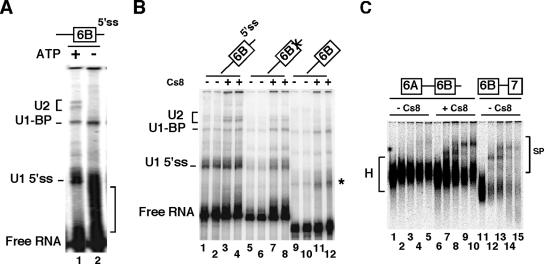FIG. 6.
(A) The interaction of U2 snRNP on the branch point requires the presence of ATP. Psoralen cross-linking experiments were performed as described in the legend to Fig. 5A, with or without ATP (lanes 1 and 2, respectively). The bracket on the right indicates intramolecular cross-linked species. (B) The interaction of U2 snRNP on the branch point requires a downstream 5′ splice site. Psoralen cross-linking experiments were performed as for panel A with wild-type pPmac-SexA1 (lanes 1 to 4) or with 5′ splice site mutated RNA (lanes 5 to 8) or with deleted 5′ splice site (lanes 9 to 12) in the absence (lanes, 1, 2, 5, 6, 9, and 10) or in the presence (lanes, 3, 4, 7, 8, 11 and 12) of 0.5 pmol of Cs8/μl of nuclear extracts. For each RNA, odd and even lanes are duplicated samples. The star represents intramolecular cross-linked species. (C) PTB prevents spliceosome complex formation. The pre-mRNA containing exon 6A, intron, and exon 6B was incubated under splicing conditions without (lanes 1 to 5) or with (lanes 6 to 10) 0.5 pmol of Cs8/μl of nuclear extracts for 0 min (lanes 1 and 6), 15 min (lanes 2 and 7), 30 min (lanes 3 and 8), 60 min (lanes 4 and 9), and 90 min (lanes 5 and 10) at 30°C. H and SP represent heterogeneous and spliceosome complexes, respectively. Lanes 11 to 15, control pre-mRNAs.

